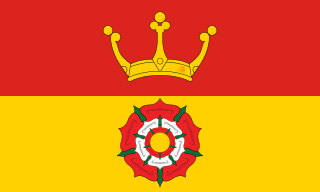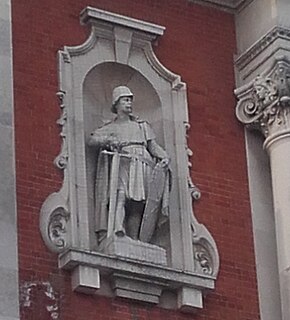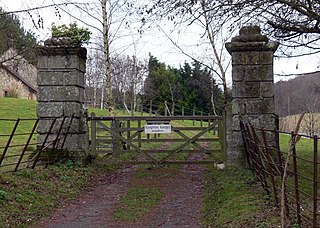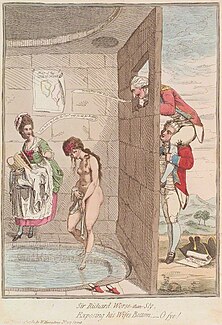Related Research Articles

Hampshire is a county in South East England on the coast of the English Channel, bordering Dorset to the south-west, Wiltshire to the north-west, Berkshire to the north, Surrey to the north-east and West Sussex to the south east. The county town is Winchester, but the county is named after Southampton. Its two largest cities are Southampton and Portsmouth which are administered separately as unitary authorities; the rest of the county is governed by a combination of the Hampshire County Council and non-metropolitan district councils.

Hampshire is a county in Southern England with some notable archaeology and many notable historic buildings.
Henry William Bristow was an English geologist and naturalist.
Baldwin de Redvers, 1st Earl of Devon, feudal baron of Plympton in Devon, was the son of Richard de Redvers and his wife Adeline Peverel.

Hampshire and Isle of Wight Constabulary is the territorial police force responsible for policing the counties of Hampshire and the Isle of Wight in South East England, United Kingdom.

Bursledon Windmill is a Grade II* listed windmill in Bursledon, Hampshire, England which has been restored to working order.

The Hampshire and Isle of Wight Fire and Rescue Service (HIWFRS) is the statutory fire and rescue service for the county of Hampshire, including the cities of Southampton and Portsmouth, and the county of the Isle of Wight on the south coast of England. The service was formed on 1 April 2021 from the merger of Hampshire Fire and Rescue Service and the Isle of Wight Fire and Rescue Service. The service's chief fire officer is Neil Odin.

St. Denys Priory was a priory of Austin canons in the St Denys area of Southampton, Hampshire, England.

Eudo Dapifer ;, was a Norman aristocrat who served as a steward under William the Conqueror, William II Rufus, and Henry I.

John Seymour of Wulfhall, of Stalbridge, of Stinchcombe and of Huish, all in Wiltshire, England, was warden of Savernake Forest and a prominent member of the landed gentry in the counties of Wiltshire, Somerset and Dorset. He was the grandfather of Jane Seymour, the third wife of King Henry VIII, and was thus great-grandfather of King Edward VI.

Sir William Russell (1257–1311) was an English nobleman, knight, and holder of a moiety of the feudal barony of North Cadbury, Somerset, but spent most of his life engaged in the administration and defence of the Isle of Wight, where he obtained by marriage the manor of Yaverland. He served as constable of Carisbrooke Castle, and sat in parliament on two occasions, firstly as burgess for Great Bedwyn, Wiltshire, and then for the County of Southampton. As a baron his military service was called on several times by King Edward I Hammer of the Scots.

Knighton Gorges Manor was one of the grandest manor houses on the Isle of Wight. Located in the hamlet of Knighton, near Newchurch, it is reported to be one of the most haunted locations on the Isle of Wight.
Lieutenant-General Maurice Bocland of Knighton Gorges in the parish of Newchurch, Isle of Wight, was a British soldier and Member of Parliament.
William de Courcy was an Anglo-Norman nobleman and baron.
The following is a timeline of the history of the city of Southampton, Hampshire, England.
Ralph fitzStephen was an English nobleman and royal official.
Manasser Biset was an Anglo-Norman nobleman and royal official during the reign of King Henry II of England. Biset was one of the most frequent witnesses on Henry's documents, and served the king as a justice and in financial matters. He was rewarded with lands in England which have led him to be considered the first feudal baron of Biset.
The Ven. Liscombe Clarke was an Anglican priest: the Archdeacon of Sarum from 1827 until 1836.

Maurice George Bisset (1757–1821) of Knighton Gorges on the Isle of Wight, and of Lessendrum in Aberdeen, Scotland, 18th Scottish feudal baron of Lessendrum, is famous for his involvement in the scandalous court case involving his mistress Seymour Dorothy Fleming and her husband Sir Richard Worsley, 7th Baronet, of Appuldurcombe House, Isle of Wight. The case was the result of his affair with Lady Worseley, by whom he had a daughter, Jane Seymour Worsley, of whom Richard claimed paternity in order to avoid scandal.
Shamblehurst, also known as Sandhust, was a manor and tithing within the ancient parish of South Stoneham, now in the modern-day Borough of Eastleigh. It had Allington tithing to the north and Botley and Durley parishes to the east.
References
- Keats-Rohan, K. S. B. (1999). Domesday Descendants: A Prosopography of Persons Occurring in English Documents, 1066–1166: Pipe Rolls to Cartae Baronum. Ipswich, UK: Boydell Press. ISBN 0-85115-863-3.
- Richardson, Douglas (2013). Royal Ancestry. Vol. III.
- Waugh, Scott L. (October 1983). "Reluctant Knights and Jurors: Respites, Exemptions, and Public Obligations in the Reign of Henry III". Speculum. 58 (4): 937–986. doi:10.2307/2853791. JSTOR 2853791. S2CID 159868579.
- Woodward, Bernard Bolingbroke; Wilks, Theodore C.; Lockhart, Charles (1861). A General History of Hampshire Or the County of Southampton Including the Isle of Wight: Southampton and Alresford, and the adjacent country. A General History of Hampshire Or the County of Southampton Including the Isle of Wight. Virtue and Company; Henry Sotheran and Company.